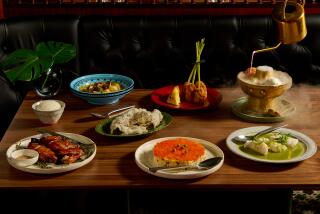Singapore’s New Rule: Preservation
- Share via
A shiny green mat, cut from a broad banana leaf, was placed in front of me at the small restaurant in Singapore’s Indian quarter. Then came lunch: a robust curry feast of tantalizing aromas--served without plates or utensils or napkins.
A waiter moved around the table, plopping spoonfuls of white rice in the middle of each leaf. Others dished out mounds of okra, corn, pink prawns, curried mutton and golden tandoori chicken. Stacks of Indian bread came next, and cold mugs of Tiger beer.
The idea is to eat with your fingers, I learned--no chopsticks, no forks, no spoons. Wet hand towels, rolled by each place mat, soon were streaked with saffron.
This was at the Banana Leaf Apolo, an air-conditioned haven where the fiery menu is from the south of India and the specialty is fish-head curry.
Two large fish heads--crowned with spring onions and swimming in red curry sauce--were served for our table of 10. As I stared at the sharp little teeth, a Singapore native whispered: “The sweetest part is right behind the eye.”
I thanked him for the tip, but concentrated on tandoori and rice.
This gloriously messy meal seemed a playful departure in Singapore, where tidiness is enforced and rules of behavior are strict.
The penalty for littering, for example, is $1,000, although visitors are given warnings. There are fines for jaywalking, smoking, sitting on parapets in train stations and failure to flush public toilets. There are circle-and-slash signs prohibiting motorcycles, loud radios and slingshots. Magazines deemed obscene are not allowed. Penalties for drug possession are horrific.
The government controls who lives in which blocks of its high-rise housing projects, in an effort, they say, to prevent ghettos. Eighty-seven percent of Singapore’s 2.7 million people live in these apartments.
The government is even involved in romance, having opened a matchmaking bureau aimed at college graduates. The bureau, operated by the social development unit of the ministry of community affairs, is nicknamed SDU, which some young Singaporeans deride as “Single, Dumb and Ugly.” The cost is $50 for the first introduction.
For travelers, strict rules can make life simple. Tipping is prohibited at the airport, and discouraged most other places. Tap water is safe to drink. English is spoken everywhere, one of four official languages, along with Chinese, Malay and Tamil.
Beautification efforts are apparent throughout the island-nation. Sky-blue garbage trucks, marked “Ministry of the Environment,” roll down the high-fashion boulevard of Orchard Road and reflect in the windows of lavish boutiques and electronics showrooms whose prices vie with Hong Kong’s. Palms and arching shade trees have been planted with a vengeance and pruned to perfection. Tropical showers keep the city fragrant and green.
The seaside Changi Airport--at the end of a landscaped highway--is amazingly artful, clean and efficient. The elapsed time from landing to hotel door beats any I’ve seen, which is welcome in this muggy climate, just one degree north of the Equator.
For 25 years, Singapore has been run like a booming corporation, hell-bent on construction and success. But in 1988, the realization hit: Tourists would not travel around the world merely to see modern skyscrapers. Singapore began investing heavily in preservation of its remaining historic neighborhoods.
Restoration programs are pursued as aggressively as any other government dictate. Suddenly, conserving the architectural heritage of old Singapore is serious business.
In Chinatown, the Malay neighborhoods and the Arab quarter, hundreds of tile-roofed, two- and three-story shop houses (shops below, living quarters above) have been shored up and freshly painted, often in cool pastels.
British colonial bungalows, with their sweeping porches and ceiling fans, have become national treasures. The best-known of Singapore’s institutions--the 1880s Raffles Hotel--reopened in September after major restoration and reconstruction.
Another shining example of preservation is Emerald Hill, a collection of turn-of-the-century terrace houses where European and Asian influences blend into something Singaporean, with Doric columns, French windows, tropical louvered doors, and gates carved with lion dancers.
Yet with all the laws and order, Singaporeans seem notably tolerant. Golden mosques and synagogues share neighborhoods. Elaborate Buddhist shrines rise near fanciful Hindu temples. The stolid Armenian Church (1835) is near St. Andrew’s Cathedral (1862).
And in Little India, just down the street from the Banana Leaf Apolo cafe, you’ll find the Foochow Methodist Church.
More to Read
Sign up for Essential California
The most important California stories and recommendations in your inbox every morning.
You may occasionally receive promotional content from the Los Angeles Times.













